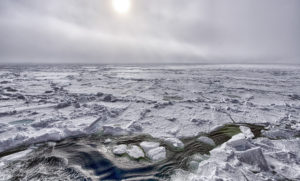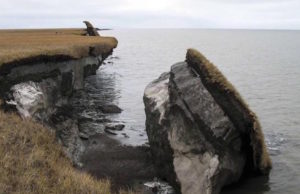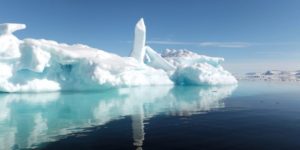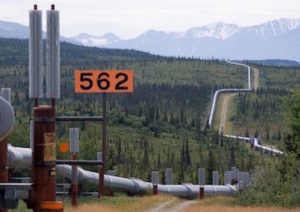Ice Melt Dilutes Arctic Sea’s CO2 Cleanup Role
New scientific research confirms that global warming is melting increasingly larger areas of Arctic sea ice -- and reducing its vital function of removing CO2 from the atmosphere.By Tim Radford, Climate News NetworkThis piece first appeared at Climate News Network.
LONDON — The Arctic ice cap has just passed its summer minimum — and it’s the sixth lowest measure of sea ice recorded since 1978, according to scientists at the US space agency NASA.
For three decades, the shrinking Arctic ice — and the growing area of clear blue water exposed each summer — has been a cause of increasing alarm to climate scientists.
Polar seasonal changes are measured annually by NASA, but reliable satellite data goes back only to 1978, For much of the 20th century, the Arctic was part of the Cold War zone, so only Soviet naval icebreakers and US nuclear submarines took consistent measurements — and neither side published the data.
But studies of 17th and 18th century whaling ships’ logbooks and other records make it clear that the ice once stretched much further south each summer than it does today.
Steady decline
In the last 30 years, the thickness and the area of the ice have both been in steady decline, with predictions that in a few decades the Arctic Ocean could be virtually ice free by September, opening up new sea routes between Asia and Europe.
This year could have been worse, although the area of ice fell to little more than 5 million square kilometres — significantly below the 1981-2010 average of 6.22 million sq km.
“The summer started off relatively cool, and lacked the big storms or persistent winds that can break up ice and increase melting,” said Walter Meier, a research scientists at NASA’s Goddard Space Flight Centre. “Even with a relatively cool year, the ice is so much thinner than it used to be. It is more susceptible to melting.”
Warming in the Arctic is likely to affect climate patterns in the temperate zones, and the state of the polar ice has become of such concern that researchers are using ground-based and sea-based monitors to explore the physics of the phenomenon.
But there is another reason for the attention: as polar ice diminishes, so does the planet’s albedo ? its ability to reflect sunlight back into space.
So, as the ice shrinks, the seas warm, making it more difficult for new ice to form. And greater exposure to sunlight increases the probability that permafrost will thaw, releasing even more greenhouse gases locked in the frozen soils.
Now researchers have found another and unexpected example of climate feedback that could affect the cycle of warming. Climate scientist Dorte Haubjerg Søgaard, of the Greenland Institute of Natural Resources and the University of Southern Denmark, and research colleagues have discovered that sea ice itself is an agency that removes carbon dioxide from the atmosphere.
That the oceans absorb the stuff, and tuck it away as calcium carbonate or other marine minerals, is old news.
“But we also thought that this did not apply to ocean areas covered by ice, because the ice was considered impenetrable,” Søgaard said. “However, new research shows that sea ice in the Arctic draws large amounts of CO2 from the atmosphere into the ocean.”
The research is published in four journals, Polar Biology, The Cryosphere, The Journal of Geophysical Research: Atmospheres and Marine Ecology Progress Series.
Two-stage pattern
The Danish research team observed a complex, two-stage pattern of gas exchange as ice floes formed off southern Greenland. They measured the role of atmospheric carbon dioxide in the formation and release of calcium carbonate crystals form in the sea ice, and kept a tally during a 71-day cycle of the carbon dioxide budget.
In the course of this complicated bit of natural cryo-chemistry, they found that some CO2 was carried deep into the ocean with dense, heavy brines, as the ice froze and some was captured by algae in the thawing ice.
They also identified a third factor: the “frost flowers” that formed on the new ice had an unexpectedly high concentration of calcium carbonate.
The profit-and-loss accounting meant that every square metre of ice effectively removed 56 milligrams of carbon from the atmosphere during the 71-day cycle. Over an area of 5 million sq km, this would represent a significant uptake.
But the real importance of the discovery is that scientists have identified yet another way in which the ice — while it is there — helps keep the Arctic cold, and yet another way in which carbon dioxide is absorbed by the oceans.
“If our results are representative, then the sea ice plays a greater role than expected, and we should take account of this in future global CO2 budgets,” Søgaard said.
Your support matters…Independent journalism is under threat and overshadowed by heavily funded mainstream media.
You can help level the playing field. Become a member.
Your tax-deductible contribution keeps us digging beneath the headlines to give you thought-provoking, investigative reporting and analysis that unearths what's really happening- without compromise.
Give today to support our courageous, independent journalists.






You need to be a supporter to comment.
There are currently no responses to this article.
Be the first to respond.